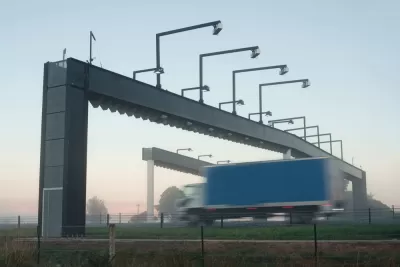Texas 130 has failed to live up to its revenue potential, leaving the private company that operates the road in junk bond status.

Katherine Blunt takes a deep dive in the revenue challenges facing SH 130 Concession Co., the private operator of the Texas 130 toll road.
According to Blunt, the company "hasn’t been able to shake the junk-bond rating Moody’s Investment Services assigned it two years ago because traffic counts on its sections have consistently failed to meet projections." Specifically, "Last year, traffic and revenue fell nearly 70 percent below the company’s original forecast, according to the ratings agency."
The article notes that traffic and revenue have been increasing slightly for several years, but not in enough quantity to rescue the company from its junk bond rating.
Blunt goes on to closely examine the toll road's shortcomings—in erms of its ability to attract the traffic necessary to make ends meet. Speaking of making ends meet, representatives from SH 130 Concession Co. blame a lack of "direct connectors" for the sluggish traffic levels. Blunt provides more context for how the road came into existence:
"TxDOT planned Texas 130 to relieve congestion between San Antonio and Austin on Interstate 35, a highway strained by population growth and cross-border trade. The department completed part of the road by 2006, but it didn’t have enough funding to build south of Mustang Ridge."
As for a more heavily travelled future for the toll road, the desired connector roads are still distant spots on the planning horizon:
"The Alamo Area Metropolitan Planning Organization has discussed the possibility of building a connector between I-35 and Texas 130 to makes the toll road more accessible from San Antonio. But City Councilman Ray Lopez, chairman of the MPO, said that project will likely take a back seat to other priorities in the area."
FULL STORY: Sparse traffic challenges Texas toll company

Maui's Vacation Rental Debate Turns Ugly
Verbal attacks, misinformation campaigns and fistfights plague a high-stakes debate to convert thousands of vacation rentals into long-term housing.

Planetizen Federal Action Tracker
A weekly monitor of how Trump’s orders and actions are impacting planners and planning in America.

Chicago’s Ghost Rails
Just beneath the surface of the modern city lie the remnants of its expansive early 20th-century streetcar system.

Bend, Oregon Zoning Reforms Prioritize Small-Scale Housing
The city altered its zoning code to allow multi-family housing and eliminated parking mandates citywide.

Amtrak Cutting Jobs, Funding to High-Speed Rail
The agency plans to cut 10 percent of its workforce and has confirmed it will not fund new high-speed rail projects.

LA Denies Basic Services to Unhoused Residents
The city has repeatedly failed to respond to requests for trash pickup at encampment sites, and eliminated a program that provided mobile showers and toilets.
Urban Design for Planners 1: Software Tools
This six-course series explores essential urban design concepts using open source software and equips planners with the tools they need to participate fully in the urban design process.
Planning for Universal Design
Learn the tools for implementing Universal Design in planning regulations.
planning NEXT
Appalachian Highlands Housing Partners
Mpact (founded as Rail~Volution)
City of Camden Redevelopment Agency
City of Astoria
City of Portland
City of Laramie



























